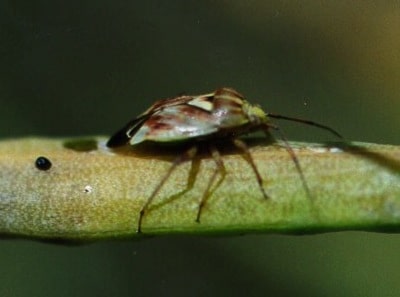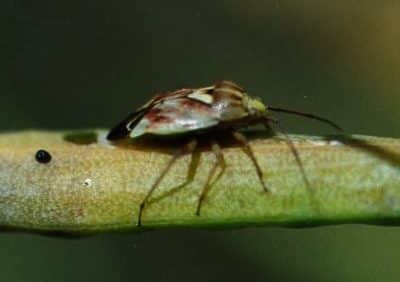In very dry conditions, lygus threshold tables based on Wise and Lamb’s research from the 1990s are still appropriate when making spray decisions. These tables indicate that if canola at the pod ripening stage is $12 per bushel and spray costs $12 per acre, the threshold is 11 lygus adults or late instar nymphs per 10 sweeps (~1 per sweep).
In moist and high-yield conditions, the economic threshold is quite a bit higher. At early pod stage, recent research from AAFC found that 50 lygus per 10 sweeps (5 per sweep) could cause a 2 bu./ac. reduction in yield.
Wise and Lamb acknowledged the possible growing condition effect in their research paper used to set the lygus thresholds. In “The Canadian Entomologist 130” pages 825-836 in 1998, they wrote: “When precipitation is greater than 100 mm from the onset of bud formation to the end of flowering, the crop may partially compensate for plant bug [lygus] damage.”

Pods are the focus. The most vulnerable crop stage for lygus feeding is after flowering and when seeds are enlarged in lower pods. (This would be around stage 5.2 for a dense stand and 5.1 for a thinner stand.) After sweep netting, look for sticky sap spots on pods, pedicels and stems before making the spray decision. Oozing points on pods suggests active feeding. If sweep net counts exceed thresholds, but there is no evidence of pod damage, growers could decide to hold off on spraying. Alternatively, if evidence of feeding is present but sweep net counts are low, try sweep netting again in another area or another time of day. Counts can be dependent on weather conditions in the sweep zone.
The threat generally ends when most pods become “leathery” and when seeds inside are no longer squishy. As outer pod tissue toughens up and seeds become firm to roll, lygus can no longer penetrate them.
Lygus thresholds for the bud and flower stages are not needed because economic loss is rare at these stages. Research shows that low level lygus feeding at flowering can actually stimulate yield. The only situation where spraying may be warranted at flowering stages is if numbers are so high that large areas of the crop are not coming into flower because the flowers are being eaten.
Situations to consider:
Rainfall. Rain improves crop growth, lowering the risk from lygus. A heavy rain at podding will also knock lygus to the ground, where ground beetles and other beneficial insects can eat them.
Number of nymphs. Late instar nymphs, the ones with the black dots on their backs, are to be included in lygus sweep net counts. If you are seeing a lot of small nymphs, check again every few days. Young nymphs do no damage because they are unable to penetrate pods. In warm conditions, it may take only a week for lygus to grow from early to late instar stages. If swathing is a week to 10 days away and most lygus are small nymphs, these nymphs are unlikely to have time to grow into a threat before the crop is cut. Photos and more helpful hints.
Other pests present. If lygus are at or above thresholds and other pests, such as diamondback moth larvae, are also feeding on pods and are near thresholds, this combination improves the potential economic return from a spray.
Lygus and cabbage seedpod weevil. According to recent research by AAFC in Alberta, CSPW and lygus do not become pests in the same fields. Early planted fields with high CSPW have very low lygus populations. Thus, there is no economic return to spray for lygus at early flower in early seeded fields.
Further reading:
Threshold tables
Lygus nymphs: Which ones do you count?
Prairie Pest Monitoring Network blog

